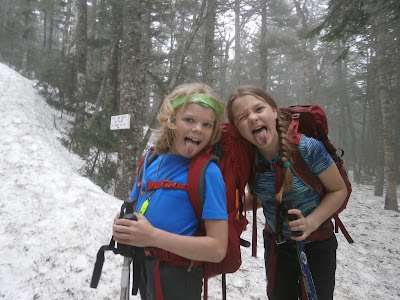 |
| No one can say that weren't warned going above tree line on Air Line |
That does not mean that no one is keeping score. This is still a human endeavor. Between the multiple peak bagging lists, FKT's, first ascents, winter ascents, and other challenges we have ways of measuring our accomplishments in the hills. Ego and ambitions are not absent from those of us who play in the mountains rather than on a ball field. Most of us who climb have objectives in mind, peaks to reach, and goals we seek.
 |
| All those mile for a patch |
These goals are almost incomprehensible to people who are not hikers or climbers. The incredulous question from some folks when I mention finishing the 48 White Mountain peaks is "you hiked all those miles for just a patch?" When the risk level is higher the lack of comprehension is greater too. "You've already climbed Mt. Washington, why would you do it in winter?" or "How could he/she leave their family just for a mountain, didn't they know it could be deadly?" "You do what with your kids? Don't you think that's dangerous?"
We know of course that climbing can be lethal. While it is easy to quote accident statistics, how it's more likely to die on the highway driving to the trail head than on the mountain, that is a blithe argument. The risk of death in the mountains is very real, and it is an overwhelming risk for the vast majority of people. Until 200 years ago that risk kept all but a very few lunatics from climbing the high mountains. The highest peaks are still fearsome places when the weather turns. Each of us who regularly play in the mountains do what we can to mitigate the risks. I often read and discuss incident reports with my son as a way of learning how mistakes occur, so that we can avoid those errors. We train our selves physically. We equip properly. We go with experienced partners. We become students of the trails, terrain, and weather. We exercise the best judgement we can.
 |
| The deadliest cue in the world, South Ridge Mt. Everest |
The strength required to climb mountains is not only physical, but mental and emotional too. That emotional strength is not only pushing through fear or discomfort, but also understanding when to reduce ambition and retreat. There are days when the decision to turn back is more important than to push on, when continuing only leads to a dangerous situation. Humility is subtle sort of strength. Attempting to climb mountains will eventually humble almost everyone, when the wind picks up and the cold exposes your vulnerability above tree line there is no where to hide. The mountain has been here for millions of years before you or I, and it will still be there for millions of years after we are gone. The mountain always wins.
 |
| heading up to Edmands Col |
Last Saturday I took my son and his best friend (co leading with her mother) on an ambitious route for 12 year olds. We planned to traverse the Northern Presidentials, the higher half of the full Presidential Traverse. While we started early, made good time up Airline, and felt fine on Mt. Madison, it was clear after Mt. Adams that we were not moving fast enough. We did go the harder path up Mt. Adams via Star Lake Trail. We also lingered too long at the Madison Hut. By the time we reached Mt. Jefferson we were 2 hours behind my plan and feeling fatigued. But it was a perfect weather day, so we were tempted to follow the plan and summit Mt. Washington. However that would get us down the Jewell trail close to dark, and home at 10:00 p.m. We also knew that a rain storm was forecast for 7-8 p.m. Once we rounded Mt. Clay the kids decided to descend. We skipped Mt. Washington rather than push on for another 3 miles. Half way down the ridge both kids said that their feet hurt, their energy was waning. They confirmed that was the right decision for this trip.
 |
| last peak of the day |
Perhaps that is the most important skill in mountaineering; assessing your present capacity and the conditions to decide when to descend, i.e. how to be humble. The phrase I've drilled the kids with all winter is "reaching the peak is optional, coming home with your fingers and toes is required". I expect that my little mountain goats will climb many many more mountains. We all love traveling in remote wild places too much to avoid them. I hope that when I no longer go with them on every trip they continue to make good decisions, that while they seek their goals it is always with humility towards the mountain.






